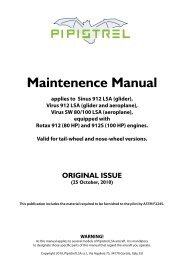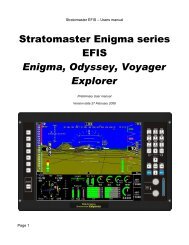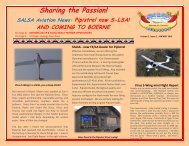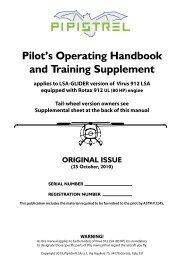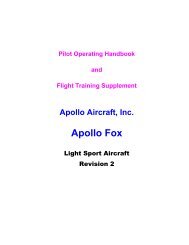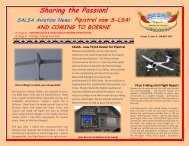Pipistrel Virus Aircraft Operating Instruction - Salsa Aviation
Pipistrel Virus Aircraft Operating Instruction - Salsa Aviation
Pipistrel Virus Aircraft Operating Instruction - Salsa Aviation
Create successful ePaper yourself
Turn your PDF publications into a flip-book with our unique Google optimized e-Paper software.
AIRCRAFT OPERATING INSTRUCTIONS – VIRUS 912 S-LSA GLIDERbelow. Apply normal engine shut down or start-up procedure. Upon restart, should the enginecool down during unpowered flight, apply choke. Always start the engine at idle throttle.8.2.8 Ground Shutdown.1. Engine speed - idling2. Instruments - engine instruments within limits3. COMM + intercom - off4. Ignition key - off5. Circuit breakers - off6. Master switch - offCome to a complete standstill by engaging brakes. Re-check RPM drop by switching ignition OFFand back ON, one by one. Leave the engine running at idle RPM for a minute in order to cool itdown. Set master switch and ignition switches in OFF position.Unlock air brakes (handle hanging down freely) and insert parachute rescue system handle’ssafety pin (if rescue system installed). Apply parking brake, if fitted. Open cabin door, unfastensafety harnesses and exit the cockpit (watch for the wheel fairings!). Block the wheels and securethe pitot tube by putting on a protection cover. Fit the tubes onto fuel tank vents so that fuel willnot spill onto the wing in event of full fuel tanks, temperature expansion of fuel and/or parkingon a slope. It is recommended to shut both fuel tank valves.CAUTION! Should the aircraft be parked on a slope it is recommended to shut one of the fuelvalves to prevent overflowing of the adjacent fuel tank.8.3 Cruise. <strong>Aircraft</strong> at MTOM, recommended cruise power of 5300 RPM at 15°C / 59°F at sealevel altitude, flaps set to negative position (-5 degrees): <strong>Virus</strong> 912 LSA - cruise airspeed 116 ktsBest economy cruising level is 7500 ft. There, cruise performance is equivalent or better than above dueto IAS-TAS relation, but fuel consumption is lower. At these parameters the fuel burn is 3.2 US gal (12.2l)per hour. For detailed fuel consumption determination for various cruising regimes consult the Rotax 912UL/ULS Operators manual.CAUTION! It is not recommended to fly the aircraft at speeds exceeding 80 kts (150 km/h) usingflap setting other than negative.CAUTION! If the fuel quantity in a fuel tank is low, it is possible that the engine starts to suck airinto the fuel system. To prevent this and consequent engine failure, always close the fuel valve ofthe tank where the fuel quantity is very low.Cruising in rough conditions:Should you experience turbulence, reduce airspeed and continue flying with flaps set to neutral position.CAUTION! In rough air, reduce engine power if necessary to keep airspeed below V A (76 kts).8.4 Approach. Descending with the <strong>Virus</strong> is the stage of flight where the most care should betaken. As the aircraft is essentially a glider, it is very slippery and builds up speed very fast.Start the descent by reducing throttle and keep your speed below V RA .During initial descent it is recommended you trim for a 10 kts lower speed than the one you decided todescent at. Do this for safety. In case you hit turbulence simply release forward pressure on the stick andthe aircraft will slow down. Also, keep in mind you need to begin your descent quite some time beforePage 32



